(http://archives.eprints.org/)
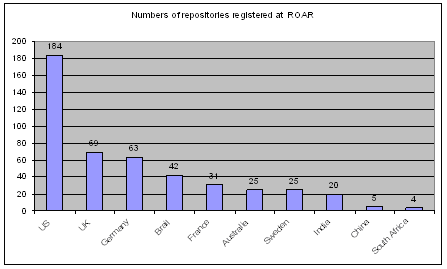
|
Xuemao Wang
Johns Hopkins University United States xmw@jhu.edu |
Chang Su
Johns Hopkins University United States changsu@jhu.edu |
ABSTRACT: Open Access (OA), a movement aiming at providing free access to scholarly literature over the Internet, has recently gained enormous momentum. Although OA started with developed countries, it is appealing to developing countries and is spreading throughout the world quickly. Based on a comprehensive literature review, this paper outlines the concept of OA, various OA operational models, and key stakeholders. Built upon deep Web searches, this paper summarizes and describes major OA projects in the developing countries with focused discussions on major issues in OA development in China. Aiming at gaining first-hand data, the authors interviewed six prominent Chinese scholars and analyzed their perspectives of OA development in China. In addition, this paper evaluates the similarities and differences of OA development by using the developed counties as best practice benchmark. This paper concludes with suggestions and recommendation of improved research methods and questions for future studies.
Open Access was initiated in the developed countries. Now OA is spreading throughout the world and many developing countries have joined the effort. OA has become an international effort, which was marked by three notable declarations known as Budapest (February 2002), Bethesda (June 2003), and Berlin (October 2003). Led by the United States, Canada, UK, EU, Australia, and New Zealand, etc., OA has made significant progress in the area of public policy, support, copyright, publisher alliance, and technology standards. Like other developing countries, China started to catch up the OA movement quickly. The first OA archive in China Qiji (http://www.qiji.cn) was launched in August 2003. One recent significant international event “International Conference on Strategies and Policies for Open Access to Scientific Information” was held in China in June 2005. OA will benefit the scholarly communication in China in two ways: access and dissemination. Chinese readers can access scholarly literature freely online from all over the world. Publications by Chinese authors and researchers can easily be distributed to readers in other countries on the Internet. However, we can not deny the fact that the developing countries are far lagged behind in OA practices.
The following major research questions will be addressed in this paper:
This paper first reviews the concept of OA. Then the existing OA operational models, various roles in OA, OA projects, and issues occurred in OA development in China are discussed. This is followed by a description of the methodology applied to discovering and analyzing the current status of OA development in China against that in the developed countries. The differences and similarities are discussed and analyzed along with limitations, conclusions, and future work.
The core element of Open Access—scholarly literature is freely available online—is recognized and accepted by most OA proponents (Suber, 2003). The ambiguity and disagreement about the concept of “Open Access” derives from how to apply this term in OA projects.
“Open Access is a property of individual works, not necessarily journals or publishers” (Bethesda, 2003). Harnad et al. (2004) identified two main roads to Open Access, “gold” and “green”, which are similar with the two strategies recommended in Budapest (2002). The “gold” road refers to OA journals, which are openly accessible immediately upon publication. The “green” road refers to OA self-archiving. In the “green” road model, the authors make their own publications available online free of charge, often in a subject or intuitional repository or on their own websites. Some OA journals are also “green”, as the journals allow the authors to publish their works online free. Generally, the “green” road is faster and cheaper, while the “gold” road is more costly and better maintained and managed. Neither of them alone can be equated to OA.
The other gray area in the concept of “Open Access” is that to what extent OA allows users to use the OA works freely. What criteria should a journal meet with in order to be qualified as an OA journal? The well-known Budapest, Bethesda, and Berlin statements all define the extents that users can re-use the OA works, with slightly variations from each other. All the three statements are “permitting any users to read, download, copy, distribute, print, search, or link to the full texts of these articles, crawl them for indexing, pass them as data to software, or use them for any other lawful purpose, without financial, legal, or technical barriers other than those inseparable from gaining access to the internet itself (Budapest, 2002). Bethesda and Berlin statement add that derivative works are also allowed. But they do not include the commercial re-use. Creative Commons (http://creativecommons.org/) allows commercial reuse of all OA contents. Public Library of Science (PLoS) (http://www.plos.org/) chose to apply the Creative Commons Attribution License (CCAL) to their journals, which is less restrictive to the users.
Open Access operational models
Open Access advocates for free use of scholarly literature. Nevertheless, scholarly literature is not free in production. It is believed that the cost for producing digital OA literature is much lower than producing the traditional print literature. But resources and human labor are still needed. This paper lists the following OA operational models. These models have been applied in some OA projects, solely by one model or in a combination of several. This paper does not propose that any operational models should be recommended or avoided in OA projects. However, identifying these operational models and discussing their characteristics may help understand the practice of OA. To decide which operational models are appropriate for a particular OA project, other factors should also be considered, such as the subject and scale.
1. Author-pays
The Author-pays model refers to the operational model “in which publication is paid for by the author, the author’s institution or research program” (Wellcome Trust, 2004). In contrast, the traditional print publication applies the “subscriber-pays” model, “in which journals are paid for by readers, libraries, and similar institutions” (Wellcome Trust, 2004). BioMed Central (BMC), an OA publisher, uses the Author-pays model. The charge for an article is in the range of $570—$1645 depending on which journal you choose to submit.
The proponent for author-pays model argues the author-pays can help achieve economic efficiency (Wellcome Trust, 2004). All authors are readers, but only some readers are authors. Therefore, authors are the group who demand services and products and they should bear the cost. It is suggested that such a model is risky and disliked by publishers and authors (Harnad and etc., 2004; Schroter and Tite, 2006). This may possibly reduce the quality and number of journals. The authors may consider publication charges while submitting their papers. The publishers may lower the cost to attract authors and provide fewer and worse services due to the budget cut. Less than half of authors are willing to pay for the publication fee (Rowlands and etc., 2004). Some authors may be unable to afford the charges.
2. External Funding
Instead of generating financial support internally, seeking financial support from external resources is another important OA operational model. Possible external funding resources include: private foundations, corporate funds, government grants, institutional grants and others.
Among the journals listed in the Directory of Open Access Journals (http://www.doaj.org), about 10 per cent are supported totally or partially through this model (Open Society Institute, 2004). Institutional and subject OA repositories are often supported by academic and research institutions. ArXiv (http://arxiv.org/), an OA repository in the fields of physics, mathematics, non-linear science, computer science, and quantitative biology, is funded by Cornell University and the National Science Foundation.
External financial resources can provide reliable and ample funds to cover the significant cost occurred in the developmental and large-scale OA projects, without adding any financial burdens to authors, readers, or publishers. Neither will it compromise the quality and services of OA projects. However, the availability of external financial resources is limited, and additional efforts to apply for the grants and raise funds are required. The other concern is the sustainability of external resources. Often the grants are time designated, such as three-year or five-year. Some may be reapplied and renewed. However, there is no definite answer for the future.
3. Fee-based Support
The fee-based support model refers to that OA publishers fund the OA projects via additional services or products for sale online, including advertising, e-commerce, off-line media, and software. Such services or products can not compromise readers’ free access to online literature. BioMed Central (http://www.biomedcentral.com) currently offers advertising services on its website, which are required to be related with biological and medical researches.
The fee-based support model makes use of the media and technological resources to generate revenues to support OA. Well-managed and subject related advertisement on the websites can be potentially useful for authors and readers. It can be a potential window to introduce the related industry to the academic and research community. The fee-based extra services can help to meet special needs of certain groups of users.
However, this model should be used with great caution and with reasonable consideration of users’ needs and receptivity. The media of OA projects is mainly to provide free access to scholarly literature. The number and quality of commercial uses should be highly regulated and well maintained. Advertisement and other commercial uses of the media should not occupy a large part of the web space nor be too distractive to the readers. The commercial use should be subject-related and of potential interests to readers. Even so, scholarly users may have objections to commercial use of OA projects.
4. Voluntary work
The voluntary work model is similar to the model used popularly by the not-for-profit organizations. Volunteers with relevant knowledge and expertise contribute to the OA projects with enthusiasm and determination, but without monetary rewards. The first OA repository in China, Qiji (http://qiji.cn/), is mainly based on this operational model. A total of 20 volunteers joined the project team to establish the current OA repository.
The voluntary work model can supply the OA projects with great resources on knowledge and expertise. However, the voluntary works may lack of rigorous accountability, which could have a negative impact on organization and management.
The voluntary work model may limit the quality and scale of the OA project. The sustainability is also questionable. To expand and improve the OA project, soon or later, other operational models need to be incorporated.
5. Personal websites
Some authors put their own publications available on their personal websites for free. Bjork (2004) stated that this is the most common OA channel today. However, such a way of publication has its limitations. These publications are widely scattered on the Web. Unless the reader knows their exact URLs, otherwise, it would be very difficult to search for them on the Web. Oftentimes, the authors manage and organize their own publications but seldom assign appropriate metadata. Therefore, there is no search tool designated to serve for such resources. The personal website is totally the responsibility of an individual. It may not be updated regularly. And there is no quality control.
Although the “personal websites” can serve for the goal of providing free scholarly literature to the public, this is not the main model that this paper will discuss about.
To choose the right operational model or a good combination of operational models is a crucial part to the success and survival of an OA project. The OA operational models are different from the conventional subscriber-pays publication model. It should be borne in mind that the main goal of OA is to remove price and permission barriers for scholarly literature. Table 1 summarizes the advantages and disadvantages of various OA operational models discussed above.
| OA Operational Models | Advantages | Disadvantages | |||||||||
|---|---|---|---|---|---|---|---|---|---|---|---|
| 1. Author-pays | | 2. External grants
| 3. Fee-based
| 4. Voluntary work
| |
Changing roles in OA
Open Access is completely different from the traditional publication model. Transforming from the traditional publication model to OA will definitely cause changes to various roles involved in the publication process, including authors, readers, publishers, funding bodies, and libraries.
1. Authors
It is the author who conducts researches, writes publications, and decides where to publish his works. No doubt that authors play a critical role in the success of OA, as OA can only survive and succeed with ample high-quality submissions.
OA provides freely online literature to the public, which potentially extends to a much larger reader group than the traditional publication does. Suber (2004) pointed out that the reason why some scholars fail to submit their works to OA may not be their opposition to OA, but because that they are unfamiliar with OA. Scholars need to be better educated of OA. The electronic submission process of OA should be easy and convenient as well. The easier and more visible OA is, the more likely authors will voluntarily submit their works.
The other big concern of authors is the impact of OA. The more the publication is used and cited, the better the research proves to be. Although the OA journals are currently not as prestigious as some conventional journals, OA can potentially be viewed by more people with no fee barriers. And studies have shown that OA may have a more significant impact (The Open Citation Project). Scholars should learn about OA and contribute actively to OA. As a result, authors can benefit more from the “dissemination” advantage of OA.
2. Readers
Readers are the biggest beneficiary of OA. Readers can access and read scholarly literature freely as long as they have connection to the Internet. They need not be affiliated with any institutions or pay any subscription fee. In this way, OA extends readership of scholarly literature beyond professional and physical boundaries. OA is a good news to the developing countries such as China, where universities and research institutions can not afford the expensive subscription fees.
Empowered with free access to scholarly literature, readers should improve their information and computer literacy. Otherwise, readers may be incapable to access or overwhelmed in the mass of information.
3. Publishers
Open Access means a big challenge to the traditional publishers, most of which aim to maximize profits. In face of OA, publishers’ reactions are varied. Some publishers are enthusiastic about OA, while others are against OA. The statistics tell us that 93% of the publishers allow authors to deposit their publications in OA (Journal policies, http://romeo.eprints.org/stats.php). More new OA publishers are also starting up, such as PLoS.
4. Libraries
Libraries are traditionally mandated to keep and maintain the collections and to provide access to scholarly literature to readers. In the era of OA, libraries should make use of their expertise and become an active contributor. Based on the responses on the discussion of the topic, “Open Access and the changing roles in libraries”, on several email-lists (Liblicense-L and ACRL Scholarly Communications List), librarians are in the best position to contribute actively to OA in various aspects:
Some libraries have established library-centered OA repositories, such as the Harvard Sciences Digital Library (HSDL). In this project, the Harvard Science Libraries took the full responsibility in implementing and managing this OA repository. To take such leadership in OA, libraries need to meet the technical and organizational challenges.
5. Funding bodies
Funding bodies here are referred to government agencies, non-government foundations, corporate foundations, and others, which provide financial support for scholarly work. Due to the close financial relationship between the funding bodies and scholars, the former have advantages in promoting OA among the latter. First, the funding bodies supply funds for OA projects. Such time-limited but significant financial resources will be of great help to transform traditional journals into OA journals and establish new OA journals and repositories. Second, the funding bodies can encourage authors to publish in OA journals and deposit their publications in OA repositories. The publication fee incurred can be covered within the research grant as well. This can improve the awareness of the OA concept among scholars and also remove the obstacle of authors’ fees. Third, it would be better if the funding bodies could mandate all grantees to make their publications resulted from the grants be openly accessible. Most authors would be willing to do this (JISC/OSI, 2004). NIH has already established its OA repository and requested that all grantees deposit their publications since May 2005.
In return, the funding bodies can benefit from the wide spread of OA. The results of the researches they supported are no longer prohibited by the publishers or subscription, but are freely available online, which can be more easily accessed and viewed by the public. This may accelerate the development of scientific research and inspire further collaboration with others.
Open Access Projects in Developing Countries
Open Access promotes equity in scholarly communication. Readers can access the literature without any economic or geographical obstacles. Today, authors from the developed countries still produce the majority of scholarly literature. Researchers from the developing world need access to the literature so that they can learn from the advanced scientific technologies and apply them to their needs. The developing countries also invest in research and development and produce solid scientific researches. They need the channel to make their high-quality contributions visible to the rest of the world.
Harnad (2005) described OA impact advantage by “OA Impact Advantage = EA +(AA) +(QB) + QA + (CA) +UA” (http://eprints.ecs.soton.ac.uk/12085/01/OAA.html). The OA impact advantage arises from the six factors in this equation, which are Early Advantage (EA), Arxiv Advantage (AA), Quality Bias (QB), Quality Advantage (QA), Competitive Advantage (CA), Usage Advantage (UA). Greene (2005) pointed out that Scientific Electronic Library Online (Scielo) has made journals published in the developing countries visible to the whole world. Some high-quality journals published in the developing countries have increased in impact factor.
The developing countries have launched their OA projects. Table 2 lists some open access projects in the developing countries, including India, Brazil, China and others. The projects have achieved great success in these countries and set up some OA operational examples and methodologies for the developing countries. The OA projects—MedIND, MedKnow in India and Scielo in Latin America—are mainly supported by their national governments and regional organizations.
| Country/Region | Project | Languages | Starting time |
|---|---|---|---|
| India | medIND (http://medind.nic.in/) | English | --Designed and developed IndMED database in 1998.
--Launched full-text version in 2003. |
| MedKnow (http://www.medknow.com/aboutus.asp) | English | ||
| Latin America (including Brazil, Chile, etc.) | Scientific Electronic Library Online (Scielo) (http://www.scielo.org/index.php?lang=en) | English, Spanish, Portuguese | March 1997 |
| China | Qiji (http://www.qiji.cn/) | Chinese | Aug. 12, 2003 |
| Chinese Preprint System (http://prep.istic.ac.cn/eprint/index.jsp) | Chinese | ||
| Sciencepaper online (http://www.paper.edu.cn/) | Chinese | 2003 |
However, no matter the number or the quality, OA journals and repositories in the developing countries are lagged behind that of the developed countries. Figure 1 shows the numbers of OA repositories registered at Registry of Open Access Repositories (ROAR). It is obvious that the developing countries have far less OA repositories than that of the developed countries. China has 5 registered OA repositories. Two of them are from universities in Hong Kong. Among the other three based in the mainland, two of them were not accessible by authors at the time of study.

Issues in practicing Open Access in China
Open Access is a relatively new concept in China. What are the issues related to OA? What should people get prepared for? Based on the review of OA practices in the world and understanding of Chinese current status, the main issues in the following areas—policy, financial, language, information technology, and perception—are identified and discussed in the paper. The analyses not only show the current OA status in China, but also reveal the big gap between China and the developed countries in OA practices.
1. Policy issues
Here the policy refers to the policies, regulations, and mandates made by governments and non-governmental organizations (NGO). While the government is assumed to be responsible for the economic and scientific development of a country, many government agencies and non-governmental organizations also play an important role in scientific development. Due to the great influences of governments and NGOs, the policies issued can make OA visible and accepted to all related parties. Thus, such policies can considerably promote the advancement of OA in their respective countries. The U.S. is one of the countries that take the leadership in OA development in the world. Such success can not be achieved without policies issued by the US government and NGOs. Table 3 only lists some examples. For more OA policy statements, please refer to Suber’s website (http://www.earlham.edu/~peters/fos/lists.htm#statements).
| Country | Issued OA Policy | Summary/Excerpt |
|---|---|---|
| US | The Sabo Bill (Public Access to Science Act)—June, 2003 | This policy states that all government-funded research should be available to all in the US and that every government agency should make the resultant publications available to the public. |
| US | NIH Open Access Policy (http://grants.nih.gov/grants/guide/notice-files/NOT-OD-05-022.html) | Beginning May 2, 2005, NIH-funded investigators are required to submit an electronic version of the author's final manuscript upon acceptance for publication directly to the NIH National Library of Medicine's (NLM) PubMed Central (PMC): http://www.pubmedcentral.nih.gov (an OA repository). |
| UK | Research Council UK (http://www.rcuk.ac.uk/access/index.asp) | RCUK requires that a copy of publications resulted from all grants awarded starting from October 2005 be deposited in an appropriate e-print repository. |
| Germany | The Deutsche Forschungsgemeinschaft (German Research Foundation, DFG) | The DFG expects the research results funded by it to be published and to be made available, where possible, digitally and on the internet via Open Access. |
| Russia | Russian Society of BioPsychiatry (RSPB) | The society called on international organizations and colleagues worldwide to join forces to support the implementation of OA and stated its support for legislative initiatives aiming at gaining free and Open Access to scientific papers that result from studies funded by state or government organizations. |
| Latin America | Salvador Declaration on Open Access (http://www.icml9.org/meetings/openaccess/public/documents/declaration.htm) | Urge governments to make Open Access a high priority in science policies including: -requiring that publicly funded research be made available through Open Access -considering the cost of publication as part of the cost of research; -strengthening the local OA journals, repositories and other relevant initiatives; -promoting integration of the developing countries’ scientific information in the worldwide body of knowledge. |
| India | The Government of India (including DST, DSIR, CSIR, DBT, DoD, DAE, DRDO, ICAR, ICMR, UGC, IITs, IISc, and NITs) (https://mx2.arl.org/Lists/SPARC-OAForum/Message/2713.html) | Authors of research papers resulting from publicly-funded research are required to deposit electronic copies of any research paper into an institutional Open Access repository immediately upon acceptance for publication. Grant holders are encouraged to publish in OA journals and the Government will cover the publication costs. |
Policies are important to promote the OA concept and influence public’s view of OA. When OA was launched in China as a new publishing model, objections and misunderstanding from various parties involved, including publishers, authors, and readers, may arise. Policies can help improve the public’s awareness of OA. At present, there is no publicly stated OA policy in China either by the government or any NGOs.
2. Financial issues
OA is to provide free online access to scholarly literature without any charges. Such a publication approach is completely different from the traditional subscriber-pays model. On the other hand, OA is not free to produce. How to fund an OA journal or repository is a key factor to launch OA projects and make them sustainable.
Earlier in this paper, several existing OA operational models are described. However, the application of these models relies on the availability of financial resources, which is limited in the developing countries. China has witnessed a dramatic development in economy and science in the last two decades. Figure 2 clearly shows the stable and great growth of China’s spending on R&D, which is promising for OA in future. However, China is still a developing country. A sharp difference appears while China’s R&D expenditure is compared with that in the developed countries, as shown in Figure 3.
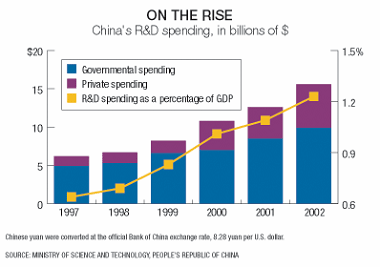
Figure 3. R&D expenditure in 2004.
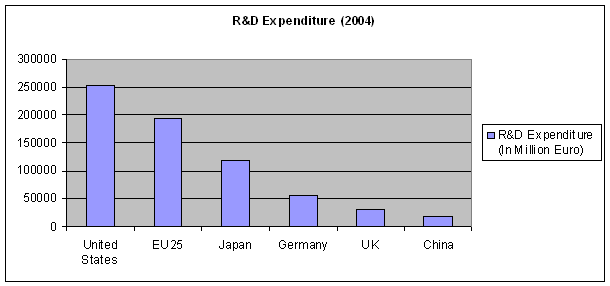
* Source from EuroStat (2005)
OA is established to serve the scholarly communication. The national R&D expenditure has great impact on countries’ total intellectual outputs. Hence, it has direct impact on supporting OA. The limitation of financial resources in China may greatly hinder the OA development in China. However, the future of OA in China regarding financial resources is still promising. First, China is undergoing a rapid development in economy, and China has been increasing its investment in R&D. Much more ample funds may be available in R&D in the future. Second, external funding is also available for OA development, such as HINARI (Health InterNetwork Access to Research Initiative) and AGORA (Access to Global Online Research in Agriculture). The Qiji repository is currently seeking funds from NSF (National Science Foundation), a US federal agency.
3. Language issues
English is the language mostly used in mainstream journals and also in most online literature. Quite a few Chinese authors write and read publications in English. Nevertheless, Chinese is the native language and widely used in China. Studies show that people, whose native language is not English, can understand information better in the native language than English (Gulbrandsen and etc., 2002). In China, most graduate students still use Chinese to write their theses or dissertations. Chinese is the major language for writing and publishing in many disciplines, such as history and political science. Based on demands of readers at various levels, OA in the Chinese language is necessary.
Momen (2005) pointed out that language is not a barrier, but quality is a barrier. Writing and publishing should never compromise the quality of the publication. Furthermore, structured abstracts and standardized formats should be applied to facilitate machine translation so as to improve the dissemination of Chinese scholarly literature. Literature written in Chinese serves the public in China. On the other hand, it limits the readership in the world. Although machine translation is available, it can never be perfect and human intervention is indispensable.
4. Information technology issues
The development of information technologies and the advancement of Web are fundamental to OA development. One country’s IT infrastructure and public ability to access the Internet have direct impact on OA. There is a huge gap of “have” and “have-not” on information technologies between the developed and the developing countries, which is known as digital divide. It is believed that digital divide has strong impact on a country’s total scientific research output.
Internet access is a major information technology infrastructure indicator. Therefore, it is used to illustrate digital divide among countries and regions. As illustrated in Figure 4, the developed world had 8 times the Internet user penetration rate of that of the developing world in 2004, though the gap has been tremendously narrowed from 73 times higher in 1994. The total Internet users reached 94 million in China in 2004, as shown in Table 4. However, it has only 7.23 Internet users per 100 inhabitants, which is much less than 53.8 Internet users per 100 inhabitants in the developed countries.
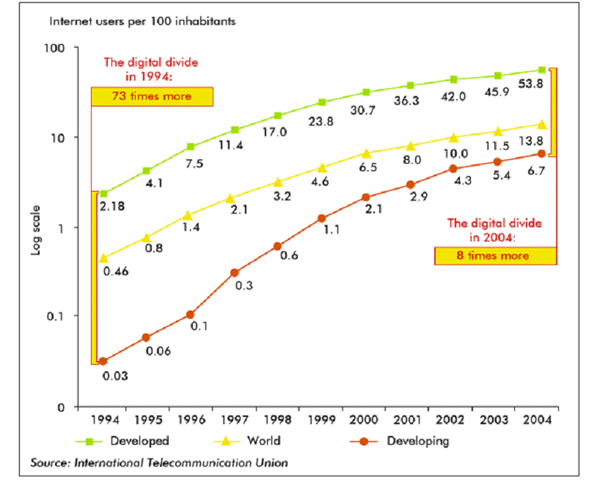
Table 4. Information technology usage
(International Telecommunication Union,
http://www.itu.int/ITU-D/ict/statistics/)

5. Scholars’ perception issues
Scholars comprise the main body of authors and readers of scholarly literature. Therefore, scholars are the core of OA. Scholars’ understanding and views of OA determine the destiny of the OA movement. Only with authors’ support and submission, the OA movement can be meaningful and successful.
Quite a few researches have been conducted to evaluate various groups of scholars’ perceptions of OA from different perspectives (JISC/OSI, 2004; Chu & Li, 2005; Schroter & Tite, 2006). Schoter and Tite (2006) conducted an electronic survey to evaluate authors’ current knowledge and perceptions of OA and author-pays publishing model. Their results show that “authors have limited familiarity with the concept of open-access publishing and surrounding issues” and “Open Access policies have little impact on authors’ decision of where to submit papers” (p. 141). JISC/OSI (2004) conducted surveys among two groups of authors, those who have published in OA journals and those who have not published in OA journals. Their results reveal the authors’ understanding, concerns, and incentives of publishing in OA journals. Chu and Li (2005) conducted a survey among 223 Chinese scientists to know their familiarity with and opinions of OA. Based on their results, they also provided some suggestions for the future development of OA in China.
The 198 respondents in JISC/OSI survey included authors from all over the world. However, most of them are from the developed countries, with only 4 from China and fewer than 20 from other developing countries. In Chu and Li’s study, all respondents are Chinese scientists. The comparison between the results of these two studies demonstrates that Chinese authors are lagged behind in understanding of and familiarity with OA journals and that Chinese authors are less inclined to publish in OA journals. Such differences demonstrate that it is critical to promote the OA concept among Chinese scholars.
Six scholars from Chinese universities, who are actively participating in research and publishing, were interviewed. However, none of them have ever published in OA journals. Therefore, they are categorized as “non-OA authors” when compared with JISC data. They were given a brief introduction of OA as they had no prior knowledge of OA. During the interview process, the authors tried to probe into details of each question in order to better understand their perceptions of OA in China. The results from the interviews were analyzed and compared with results from JISC/OSI and LCAS (Library of Chinese Academy of Sciences) studies (Chu and Li, 2005).
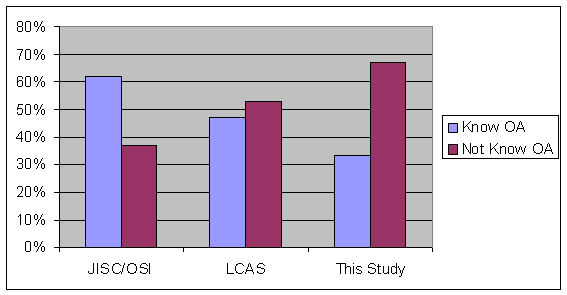
2. Scholar’s attitude towards OA
Question 3 asked the scholars about their inclination to publish in OA journals. Figure 6 compares the results from similar questions in the three studies, JISC/OSI, LCAS, and this study. Although fewer Chinese scholars are aware of OA, there is only slightly difference in the percentage of authors who are willing to publish in OA journals between JISC/OSI and LCAS studies. In this study, all the interviewees stated that they are willing to publish their papers in OA journals.
Major reasons for their willingness to publish in OA journals:
Major reasons for their unwillingness to publish in OA journals:
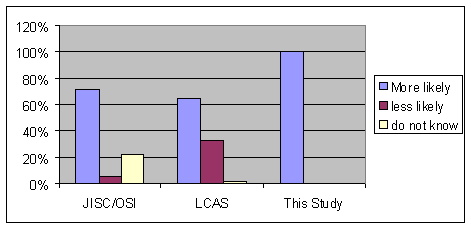
3. Public policy and funding bodies support of OA
Question 6 explored whether the Chinese government has any policies in supporting OA in China. Four interviewees expressed that they had no knowledge of any policies in supporting OA while the other two have known some. They all stated that the government support was very important, especially in China, due to the significant influence of the government to the public. Without the government support, OA will be “mission impossible” in China. This suggests that the education and promotion of the OA concept among the government officials are one important step to develop OA in China. However, most of the interviewees in this study were quite positive to win the government’s support of OA in China. One interviewee said that “the Chinese government has clearly stated that China is on the way to be a creative society and that they are also willing to learn from the successful experiences from the developed countries”.
Question 7 asked the interviewees whether their institutions had offered any encouragement and incentive to make their publications available as OA. None of the interviewees in this study knew that their institutions had anything like that. All of them wish that their institutions could cover the publishing costs incurred.
Question 8 asked the interviewees whether they were willing to pay for the publication fee for OA, what the reasonable publication fee is, and who should pay. One interviewee was very willing to pay, four were willing to pay, and only one had some reservations. The interviewees said that in China, the publication fee was common for traditional journals and authors were already familiar with the concept of publication fee. This is coincident with the statistics in LCAS study—totally 74.8% of the respondents reported that they have paid to publish in traditional or OA journals. JISC study also states that for OA authors, “the publication fee has not been a major issue, certainly not hampering their use of Open Access journals” (p. 33).
Five interviewees agreed that $500 would be reasonable and one agreed with $1,000. Figure 7 compares the amount of the publication fee that non-OA authors would like to pay in JISC study with the result from this study. The interviewees in this study said that in China the publication fee was within the range of from RMB300 to RMB3,000 and the average fee was about RMB1,000. Three of the interviewees emphasized that the amount of authors’ fee should be correlated with the impact factor of the journal. If the OA journal has a high impact factor, they are willing to pay more for the publication fee. This is similar to the concerns that authors stated in JISC study. In this study, one interviewee said that a lot of institutions in China now awarded the scholars for publications in the journals with a high impact factor, and some institutions even explicitly related this with their tenure promotion.
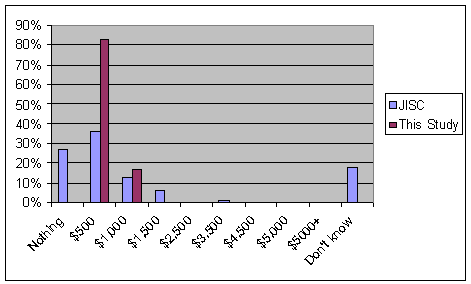
For the question of who should pay, the interviewees were provided with four choices, including authors themselves, government, funding bodies, and their institutions. Funding bodies and their institutions were the top two among their answers, while only 1 interviewee chose the government and none of them thought that the authors should pay for the cost out of their own wallets. This result is quite similar with that of JISC study. Most authors agreed that the publication fee should be covered by research grants and/or institutions and would not like to pay by themselves.
4. Importance of “peer-review” of OA publishing
Question 10 asked the interviewees to evaluate the importance of “peer-review” of OA publishing in their perception. As shown in Figure 8, the level of importance of “peer-review” in scholars’ perception is different. Most of respondents in JISC study agreed that “peer-review” was very important while most of interviewees in this study agreed that “peer-review” was important to certain extent. The interviewees in this study stated that “peer-review” is a necessary quality control mechanism that ensures scholarly literature published to be true, original, and meaningful. However, they still have some reservations due to the following reasons they expressed: 1) Some editors may be biased and therefore may not accept some creative research findings; 2) the quality and strictness of “peer-review” should be closely related to the impact factor of the journal.
As there is no comparable questions in LCSA’s survey, no data from LCSA survey is discussed here.
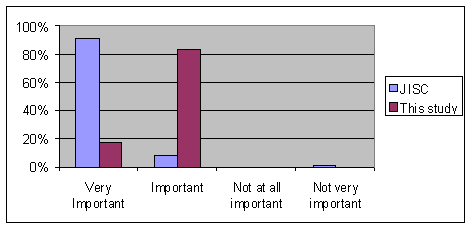
5. OA development and implementation issues in China
The last three open-ended questions in the questionnaire explored the OA development and implementation issues in China in three areas, including the major difficulties to promote OA in China, the major reasons for the success of OA in the developed countries, and the suggestions to implement OA in China. Their opinions are concluded as follows:
Major difficulties to promote OA in China:
Major reasons for the success of OA in the developed countries:
Suggestions to implement OA in China:
This paper describes the characteristics of various OA operational models—author pays, external grants, fee-based support, voluntary work, and personal website. OA will significantly impact various parties involved, including authors, readers, publishers, funding bodies, and libraries. These parties need to be well aware of and get prepared for the great benefits as well as challenges upcoming.
OA was initiated in the developed countries, and now it has become an international movement. The authors acknowledge that the developed countries are much more advanced in OA development and implementation than the developing countries. The developed countries may continue taking the leadership in the OA development in the near future. The developing countries are now actively participating in the OA movement and catching up the huge gap with the developed countries. Many OA projects have established or are starting up in the developing countries. It is the authors’ belief that OA will benefit the developing countries in the two-way scholarly communication and accelerate the development of science accordingly.
However, the OA development still has a long way to go in the developing countries, such as China. Issues in five areas are identified and discussed, including policies, financial resources, language, information technologies, and scholars’ perceptions. These do not suggest that OA in China is not feasible, but rather surface the difficulties and challenges in the OA development. The facts and statistics also demonstrate that China is undergoing a rapid advancement in the development of economy, science, and information technology. The future of OA will be challenging but promising.
The results of this study reveal that Chinese scholars are lagged behind than their peers in the developed countries in their awareness of OA. However, their enthusiasm for the OA movement and their willingness to publish in OA are not much less. Their support is fundamental to the success of OA in China.
The Chinese government and funding bodies currently have taken very limited explicit effort to promote OA in China. None of the scholars interviewed had any knowledge of it. Their buy-in and support for OA are critical to the success of OA in China. The government and funding bodies from some developed countries have already set good examples.
OA journals should never compromise the quality of journals. And the “peer-review” process, which serves as the quality control mechanism in publication, is very important to OA. Many valuable and constructive suggestions and recommendations on various aspects were offered by the interviewees.
This study is in the preliminary phase of the comparative study of OA in China and the developed countries. Due to time and labor constraints, this study only interviewed six Chinese scholars. The authors would like to extend the survey to more Chinese scholars as well as scholars from the developed countries, such as US.
The results from this study are very informative and valuable, which inspire further investigation into researches on OA, such as the correlation between the country’s economic level and its OA development, the correlation between the level of OA receptivity and the research subject field, the relationship between the level of information literacy in a country and the OA development, and how to evaluate and control the peer-review process in OA journals. The authors would also like to explore how OA policies are applied to diverse international communities that do not share common ideologies and political structures.
| Wang, Xuemao, & Su, Chang. (2007). Open Access—Philosophy, Policy, and Practice: A Comparative Study. Chinese Librarianship: an International Electronic Journal, 23. URL: http://www.iclc.us/cliej/cl23WangSu.htm |